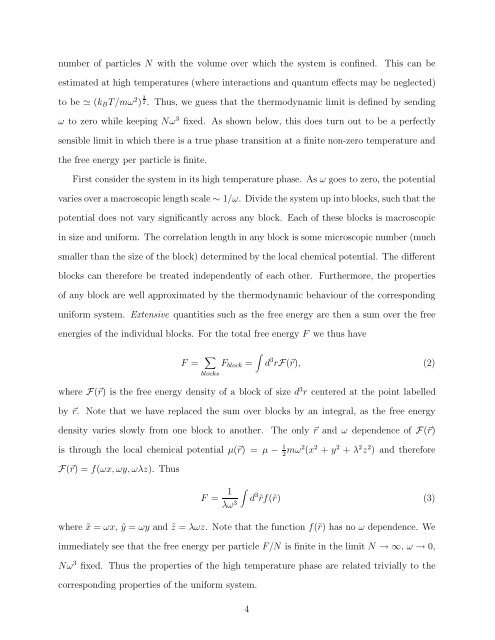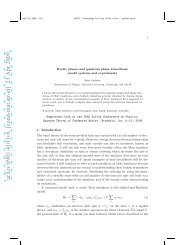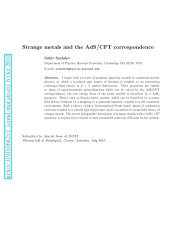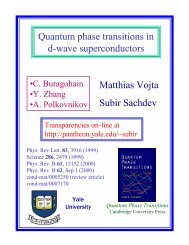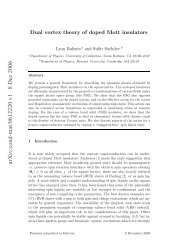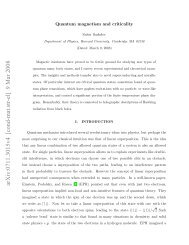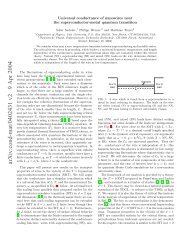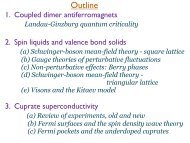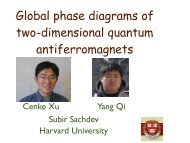Phase transition of a Bose gas in a harmonic potential
Phase transition of a Bose gas in a harmonic potential
Phase transition of a Bose gas in a harmonic potential
You also want an ePaper? Increase the reach of your titles
YUMPU automatically turns print PDFs into web optimized ePapers that Google loves.
number <strong>of</strong> particles N with the volume over which the system is conf<strong>in</strong>ed. This can beestimated at high temperatures (where <strong>in</strong>teractions and quantum effects may be neglected)to be ≃ (k B T/mω 2 ) 3 2 . Thus, we guess that the thermodynamic limit is def<strong>in</strong>ed by send<strong>in</strong>gω to zero while keep<strong>in</strong>g Nω 3 fixed. As shown below, this does turn out to be a perfectlysensible limit <strong>in</strong> which there is a true phase <strong>transition</strong> at a f<strong>in</strong>ite non-zero temperature andthe free energy per particle is f<strong>in</strong>ite.First consider the system <strong>in</strong> its high temperature phase. As ω goes to zero, the <strong>potential</strong>varies over a macroscopic length scale ∼ 1/ω. Divide the system up <strong>in</strong>to blocks, such that the<strong>potential</strong> does not vary significantly across any block. Each <strong>of</strong> these blocks is macroscopic<strong>in</strong> size and uniform. The correlation length <strong>in</strong> any block is some microscopic number (muchsmaller than the size <strong>of</strong> the block) determ<strong>in</strong>ed by the local chemical <strong>potential</strong>. The differentblocks can therefore be treated <strong>in</strong>dependently <strong>of</strong> each other. Furthermore, the properties<strong>of</strong> any block are well approximated by the thermodynamic behaviour <strong>of</strong> the correspond<strong>in</strong>guniform system. Extensive quantities such as the free energy are then a sum over the freeenergies <strong>of</strong> the <strong>in</strong>dividual blocks. For the total free energy F we thus haveF = ∑ ∫F block =blocksd 3 rF(⃗r), (2)where F(⃗r) is the free energy density <strong>of</strong> a block <strong>of</strong> size d 3 r centered at the po<strong>in</strong>t labelledby ⃗r. Note that we have replaced the sum over blocks by an <strong>in</strong>tegral, as the free energydensity varies slowly from one block to another.The only ⃗r and ω dependence <strong>of</strong> F(⃗r)is through the local chemical <strong>potential</strong> µ(⃗r) =µ − 1 2 mω2 (x 2 + y 2 + λ 2 z 2 ) and thereforeF(⃗r) =f(ωx, ωy, ωλz). ThusF = 1λω 3 ∫d 3˜rf(˜r) (3)where ˜x = ωx, ỹ = ωy and ˜z = λωz. Note that the function f(˜r) hasnoω dependence. Weimmediately see that the free energy per particle F/N is f<strong>in</strong>ite <strong>in</strong> the limit N →∞, ω → 0,Nω 3 fixed. Thus the properties <strong>of</strong> the high temperature phase are related trivially to thecorrespond<strong>in</strong>g properties <strong>of</strong> the uniform system.4


